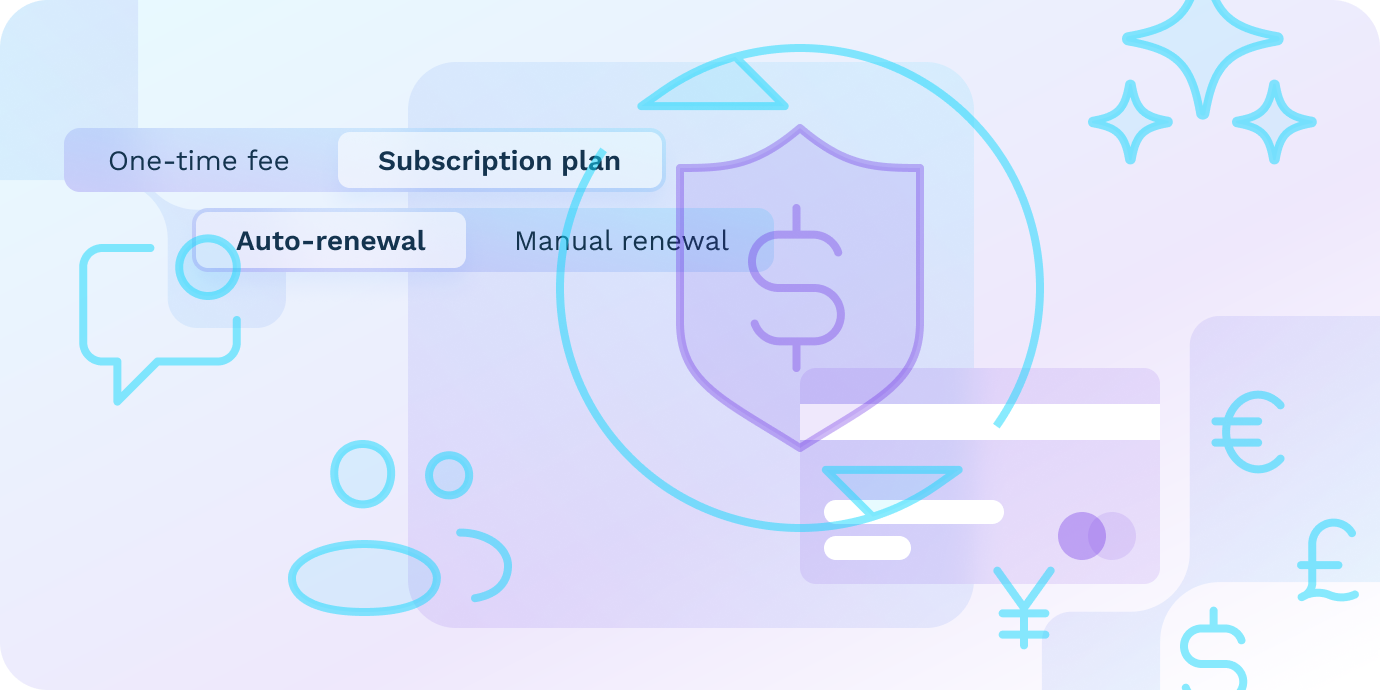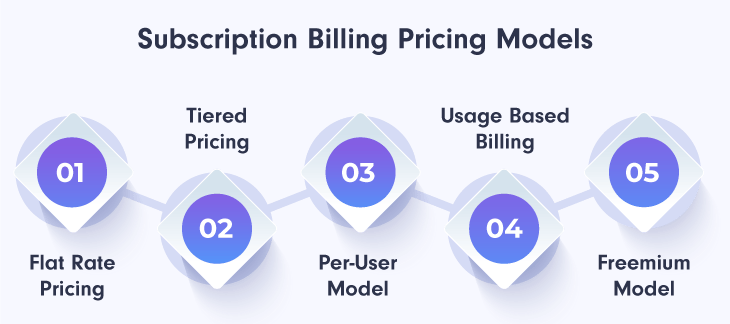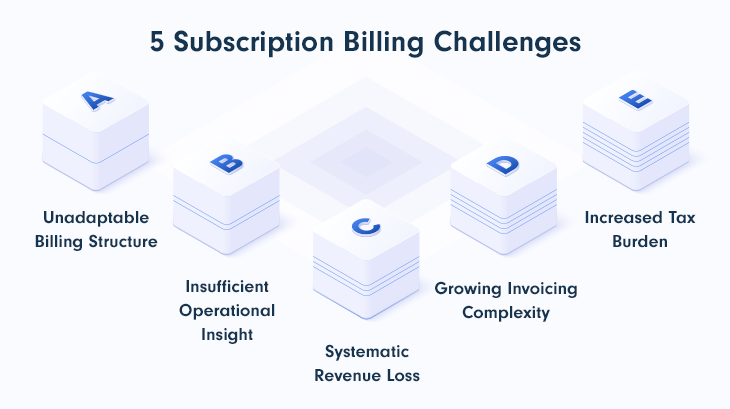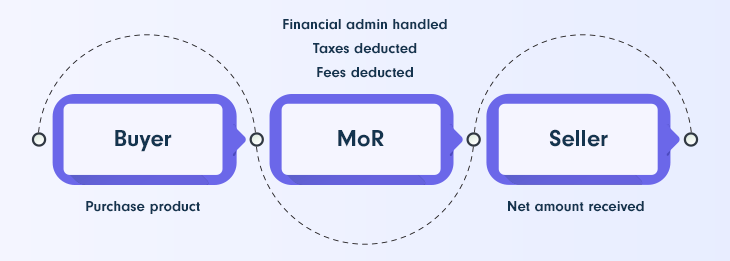SaaS Subscription Billing Guide: Challenges & Solutions

Expected to reach $1.5 trillion by 2025, recurring payments are the preferred billing choice for most eCommerce brands. While revolutionary, recurring billing is not without its challenges.
59% of subscription companies encounter significant customer friction due to billing misunderstandings, whereas 32% of them have technical issues when introducing new pricing plans leading to time-to-market delays.
So, yes, even though the subscription billing model can ensure SaaS business growth, its complexities can often leave businesses uncertain and puzzled.
In this article, you’ll get a thorough understanding of recurring billing management by looking at:
What is SaaS Subscription Billing?
SaaS subscription billing is a comprehensive business approach where customers are charged on a regular basis—be it monthly, annually, or other predefined intervals—for products or services.
How Does SaaS Subscription Billing Work?
With the recurring payment model, customers receive invoices at set intervals, and they can:
Manually submit orders through different payment methods each time.
Allow their payment information to be kept on file and used on a recurring basis.
Considering how subscription billing works, it’s important to clarify that it includes several fundamental aspects:
Triggering billing cycles
Invoice delivery
Payment collection
Subscription management
Automated retries and smart payment routing to reduce failed payments and involuntary churn
Destination-based tax calculation and automated compliance for international expansion
SaaS Subscription Billing Pricing Models
One of the key features of the recurring billing model is its flexibility. Because you can offer different pricing models and packages, you can better cater to various customer preferences and ultimately increase your recurring revenue potential.

Here’s a rundown of the most popular subscription models:
Flat Rate Pricing
This is the most straightforward pricing model, and it is an excellent option for subscription businesses with a clear value proposition and target audience.
When opting for fixed billing, your customers pay the same price on a recurring basis for access to your product. Through a single price point, SaaS brands are simplifying the customer’s decision-making process.
Example: A software company offering a simple project management tool at $10/month per user.
Tiered Pricing
Unlike the previous model, this is a flexible pricing strategy where subscription-based businesses offer several price points to their targeted clients. These are known as tiers, and they differ based on different criteria, such as usage, users, or features.
Tiered pricing’s major benefit is that brands can target different market segments by responding to multiple needs and requirements. Additionally, with gradual increases, multiple ters allow for cross-selling and upselling opportunities.
Example: A SaaS analytics platform offering Basic, Pro, and Enterprise tiers.
Per-User Model
Common in the world of B2B and SaaS products, the per-user model billing logic hinges on the number of users who access the platform. The more users, the higher the price, of course.
What is most useful about this billing option is that it offers flexibility and predictability to both the merchant and the customer. It provides multiple subscription plans allowing the user the ability to meet their business needs.
Example: Video conferencing software like Zoom charging per user license.
Usage Based Model
Employed mostly in industries like telecommunications, and cloud computing, usage-based monetization is also successfully applied for SaaS brands.
In this context, the client is charged based on their product usage.
But here is the thing. You can apply this model in the traditional manner, calculating usage and billing accordingly or you have the option to use a hybrid option.
In this variation, you can set up thresholds with a flat price. Once those thresholds are exceeded, different fees are then applied.
Example: A game development platform charging based on API calls or server time.
Freemium Model
One of the stars of subscription marketing strategies, called freemium, is a popular choice for SaaS businesses.
Freemium pricing provides interested users with access to a product version with limited functionality at no cost. The intention is to convince them to upgrade to a paid tier and enjoy the full power of the app for a price.
However, you mustn’t confuse free trials with freemium. While they are both solid strategies for attracting and upgrading customers, they differ in approach.
Free trials have limited time access and a greater urgency to convert, whereas the freemium model can be used over prolonged periods of time.
Example: An online multiplayer game that is free to play but offers premium upgrades.
5 SaaS Subscription Billing Challenges

Unadaptable Billing Structure
The subscription-based business model offers significant advantages in flexibility for both users and brands, driving faster business growth, enhanced customer relationships, and increased revenue.
However, without a scalable billing infrastructure, these benefits become unattainable.
As your SaaS expands, managing new customers, pricing changes, subscription updates, and international expansion all introduce complexity. Factors such as compliance regulations, automated tax calculations, and multi-currency payments add to the challenge.
And on top of that, you need to move fast because successful business scalability is a time-sensitive matter.
Keep this in mind: a growing business will eventually outgrow an outdated subscription management platform.
Merchant of Record (MoR) solutions help by assuming responsibility and ensuring Recurring revenue optimization International tax compliance for software subscriptionscompliance, streamlining global sales without requiring local legal entities.
Insufficient Operational Insight
SaaS metrics are very much like success compasses. Follow the right one, and you’re bound to reach your destination (eventually).
Churn, MRR, ARR, or ACV, are just a few examples of what subscription companies should be tracking if you wish to answer critical questions like:
Is my SaaS business profitable?
Am I offering sufficient payment methods?
What’s the strongest product functionality?
Is my pricing strategy done right?
Why am I losing my subscribers?
Detailed SaaS analytics is essential for obtaining actionable insights and identifying growth opportunities. However, an outdated and unstable subscription billing system acts as a roadblock, hindering your gathering of this crucial data.
MoR platforms can centralize and standardize reporting, helping SaaS teams focus on analytics, not reconciliation.
Systematic Revenue Loss
Subscription products face a persistent challenge: revenue loss due to failed payments and involuntary churn.
Whether it’s expired cards, insufficient funds, or bank errors, failed payments occur. This is part of how the world of eCommerce functions. The danger is the domino effect triggered by these lost transactions, further amplifying involuntary churn.
Additionally, with involuntary churn being a massive part of churn in general, your subscription channel could end up bleeding revenue.
Of course, there is a solution, multiple, if we’re being honest. Automated retries, backup payment methods, dunning management, and smart payment routing all qualify as effective revenue recovery best practices.
However, only a modern subscription billing platform will have these necessary features.
Modern systems with automated retries and smart routing improve payment success rates, meaning recurring revenue optimization. Dunning management and customizable email campaigns are essential features, allowing for subscription churn reduction.
Growing Invoicing Complexity
Subscription brands thrive on recurring revenue, but managing invoices is a major headache as your customer base and product catalog grow.
Offering multiple pricing plans, discounts, and promotions, being able to collect payments on a global scale, switching to different monetization strategies, and handling prorated billing all introduce increased complexity.
As a result, this leads to time-consuming manual work leaving room for greater error risk and potential revenue loss.
Without joining forces with a fully-featured, comprehensive subscription billing system, this challenge will not be completely overcome, and in time, it will undoubtedly contribute to a growing churn rate.
MoR providers offer automated invoicing solutions that ensure accuracy and compliance.
Increased Tax Burden
Business growth requires greater attention to ever-changing tax regulations, especially if you are considering expanding your SaaS operation overseas.
With each region having specific taxation rules and regulations, billing existing customers, registering, collecting, and filing the right amount of tax in every country becomes a complicated process.
Without establishing solid partnerships with subscription billing systems with the required features to handle these complexities, e-commerce developers might find it difficult to achieve long-term success.
MoR solutions automatically manage VAT, GST, and sales tax based on buyer location—essential for software, SaaS, and gaming companies selling internationally. These solutions also ensure PCI DSS compliance.
Why Use SaaS Subscription Billing Software?
Managing multiple subscriptions can be a daunting task. Not to mention that it can expose the business to a multitude of risks and challenges.
Investing in recurring billing software is the natural choice of action in the current dynamic landscape. Here is what you gain as a result of this strategic move:
Efficiency and Automation: By automating repetitive tasks like invoicing, payment processing, and subscription management, SaaS merchants are saving more time and allowing their teams to focus on more strategic efforts.
Greater Accuracy and Consistency: Task automation eliminates human calculation errors by automating and ensuring accuracy in billing, leading to fewer billing disputes and improved customer trust.
Improved Customer Experience: Through features like automatic reminders, a self-service customer portal, alternative payment methods, and currencies, reputable subscription billing platforms offer seamless billing and boost customer retention. Moreover, these solutions offer subscription lifecycle management.
Scalability: As your business grows, so do the billing complexities. Introducing new subscription tiers or add-ons, having to manage greater customer volumes with different payment preferences, and complying with various mandatory tax and compliance requirements need a scalable foundation. This can only be achieved by externalizing these operational burdens to a comprehensive, fully-featured e-commerce payment solution.
Fraud prevention for digital subscriptions and chargeback handling: MoR platforms like PayPro Global provide built-in fraud prevention tools tailored to digital businesses. This leads to significant Revenue recovery
How To Choose The Right Recurring Billing Platform
When it comes to deciding on the right subscription billing solution, it’s important to keep in mind that you aren’t simply looking for help in managing recurring payments.
Your partner should provide you with additional features to allow your business to reach global audiences and track your overall performance. So, consider the following functionality when reviewing your options:
Dunning Management
Through automated payment reminders and notifications, dunning management helps businesses recover failed transactions and reduce involuntary churn.
Scalable Infrastructure
Through open APIs and strong integration capabilities, your business benefits from a scalable solution capable of swiftly accommodating higher subscription volumes and complex workflows.
Customer Support
Dedicated customer support is essential for troubleshooting payment issues and clearing up misunderstandings before they become a requests for a service pause or cancelation.
Recurring Billing Automation
Your solution partner should be able to provide you with automation capabilities in terms of recurring billing operations like payment, collection, plan renewal, and invoicing to reduce your manual work and improve efficiency.
Flexible Pricing Options
A worthy recurring payments software should have the ability to sustain a flexible pricing strategy, offering multiple subscription billing models and frequencies, ensuring an effortless switch between them, and providing brands with multiple payment options to cater to diverse customer preferences.
Software subscription Management
Consider improved subscription management capabilities to adequately handle sign-ups, upgrades, downgrades, cancellations, and prorations, all connected with subscription lifecycle management. Additionally, having the option to set up custom billing rules, discounts, promotions, and audience-targeted billing cycles is definitely a must.
Data Compliance and Security
Expanding internationally and locally requires your business to comply with different industry regulations, including PCI DSS compliance (which is a mandatory requirement). Additionally, correctly handling all payment details is required in order to maintain payment security, together with fraud prevention for digital subscriptions.
Subscription Analytics and Reporting
Having quick and easy access to real-time subscription analytics and reporting allows you to track key subscription metrics and measure your brand’s performance.
eCommerce Partner
Thrive with the industry's most innovative all-in-one SaaS & Digital Goods solution. From high-performing payment and analytics tools to complete tax management, as well as subscription & billing handling, PayPro Global is ready to scale your SaaS.
Sell your SaaS globally with PayPro Global!
SaaS Subscription Billing Statistics Worth Knowing
The subscription billing model is an option that business owners are considering more and more. And looking at the numbers, it comes as no surprise. Here are a few statistics worth remembering:
The average subscription billing vendor is growing 30%–50% annually. With their portion of the profits from this growing trend for subscription-based businesses, subscription management software as a service (SaaS) companies have a bright future.
This year, the subscription economy is set to reach a market size of $1.5 trillion. There is no doubt that the subscription billing market is booming.
The U.S. consumes 53% of all digital subscriptions. Selling saas and subscriptions in the US requires a strong partnership that can help business owners enter this market.
Subscription businesses have grown 4.6x faster than the S&P 500. This is most likely related to the fact that businesses with recurring revenue are better able to forecast. Additionally, as client attrition may be their greatest weakness, companies must prioritize the customer experience more.
48% of subscription businesses struggle to meet accounting and reporting challenges. Once an organization starts receiving monthly payments, finance teams are faced with entirely new issues, such as effectively computing deferred revenue liability on balance sheets and having good interaction between billing and accounting systems.
Is the Merchant of Record a Solution?
Yes, the Merchant of Record is a valuable solution from the payments, risk and business perspective.

Acting as your reseller, this business model performs several payment-related operations, such as:
International SaaS payment processing
Access to different payment methods and local currencies
Having the expertise and latest technology, a Merchant of Record can ensure a faster time to market when looking to launch a new service or expand in new territories. You are no longer losing time setting up local entities in each market you want to sell or invest resources to assemble your own payment infrastructure.
However, keep in mind that not all MORs are built the same. So when choosing the right partner for your SaaS or e-commerce business, it’s important to assess them thoroughly and carefully consider your business needs. On the surface it may appear you are comparing apples to apples, when often this is not the case.
A quick call with a reputable provider will help you ensure you are moving in the right direction and that the partnership will be a successful one.
Vifdeo game monetization example: A video game company using an MoR to launch DLC across 20 countries without setting up local legal entities.
eCommerce Partner
Thrive with the industry's most innovative all-in-one SaaS & Digital Goods solution. From high-performing payment and analytics tools to complete tax management, as well as subscription & billing handling, PayPro Global is ready to scale your SaaS.
Sell your SaaS globally with PayPro Global!
How Can PayPro Global Help?
PayPro Global effectively combines the MOR business model with advanced subscription management capabilities, providing SaaS and software vendors with a complete payment solution.
With over 15 years of experience in the industry and an excellent track record, our SaaS subscription management solution gives you the benefits of streamlined operations, reduced risk, and global reach, all coupled with features specifically designed for subscription businesses.
You can easily experiment and quickly respond to growth opportunities with access to multiple pricing models, monthly or annual subscriptions, manual, automatic, or on-demand renewals, upgrades, and real-time payment reporting.
Additionally, by providing you with automated billing, best-in-class dunning management, smart payment routing, and our 24/7 multilingual customer support, we help drive more recurring revenue and prevent churn by lowering transaction failure rates while considerably reducing your staff's workload.
As a certified PCI-DSS Level One partner committed to global compliance, we uphold the most rigorous payment security standards, offer fraud prevention for digtal subscriptions and international tax compliance for software subscriptions, ensuring that payments are not declined due to compliance issues.
Find out more about how our all-in-one payment solution can strategically help your recurring business grow in global markets, or book a demo and let our specialists show you how advanced the platform is.
Final Thoughts
SaaS Subscription billing might have complexities, and they might even seem difficult to surpass.
However, by harnessing the power of strong software and an experienced partner, these intricacies become mere road bumps on your path to success.
When chosen correctly, they provide your company with increased efficiency, consistency, and accuracy. Taking your subscription business globally is no longer a dream but a real and attainable business goal that is much easier than you ever imagined.
Frequently Asked Questions
What is subscription billing?
Subscription billing is a business model in which users are billed at set intervals to access different products and services.
How does subscription billing work?
Within the subscription billing approach, customers are billed at set intervals ( monthly, annually, and quarterly). They can be charged manually or automatically if they allow their payment information to be regularly used.
What are the popular subscription billing pricing models?
Recurring billing businesses can approach different monetization models, and the most popular ones include flat rate pricing, tiered pricing, usage-based, and per-user model billing.
What challenges do subscription billing businesses face?
Some of the biggest challenges subscription-based businesses face are unscalable billing structure, reduced operational insight, invoicing complexity, and continuous revenue loss. Together, these challenges can hinder overall business growth.
Why use subscription billing software?
There are several advantages that come with implementing a robust subscription billing software. A recurring billing system will automate and simplify key processes like invoicing, payment processing, and subscription management. This will lead to improved efficiency and accuracy, streamlining both business scalability and customer experience.
Ioana Grigorescu
Ioana Grigorescu is PayPro Global's Content Manager, focused on creating strategic writing pieces for SaaS, B2B, and technology companies. With a background that combines Languages and Translation Studies with Political Sciences, she's skilled in analyzing, creating, and communicating impactful content. She excels at developing content strategies, producing diverse marketing materials, and ensuring content effectiveness. Beyond her work, she enjoys exploring design with Figma.
-
1.Explore PayPro Global's Solutions: See how our platform can help you streamline your payment processing and boost revenue.
-
2.Get a Free Consultation: Discuss your specific needs with our experts and discover how we can tailor a solution for you.
-
3.Download our Free Resources: Access valuable guides, checklists, and templates to optimize your online sales.
-
4.Become a Partner: Expand your business by offering PayPro Global's solutions to your clients.
- Managing diverse pricing models, international payments, and churn can easily hinder expansion and success.
- A comprehensive recurring billing solution is how you remain competitive within this dynamic landscape.
- The right recurring billing partner goes beyond straightforward subscription management, offering additional features to support your SaaS’s global growth.
Get the latest news



